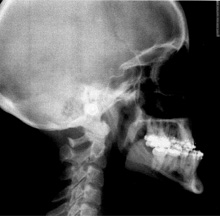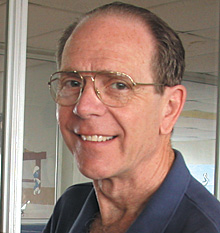Summer 2010: Dynamic Forces

Mirror image: Identical twins Amanda Bartelme and Rebecca Squires are glad they still look alike after corrective jaw surgeries.
Ann Borden


Courtesy Rebecca Squires

virtual success: Oral and maxillofacial surgeon Steven Roser used a new virtual imaging software to prepare for the twins’ surgeries; Squires’s X-rays show her jaw alignment before (top) and after.
Emory Photo/Video
Reason to Smile
New 3-D imaging software helps a surgeon perfect a complicated jaw surgery—twice
By Mary J. Loftus
Twitter from Rebecca Squires, 1:49 p.m., December 16, 2009: “Still recovering from jaw surgery—slowly but surely. Having your jaws wired shut is no fun!!”
Rebecca Squires and her sister, Amanda Bartelme, both thirty-two, are mirror-image identical twins—a subset of identical twins who appear to be exact reflections when facing each other.
Squires first noticed this when they were children: if she lost an upper right baby tooth, Bartelme would lose an upper left one.
The sisters also shared a misalignment of the jaws and a severe underbite that became troublesome as they grew older.
“We had braces for five years, but an orthodontist finally told us that braces wouldn’t fix what we had,” Squires says. “Our bottom jaws were too big and too far forward; our top jaws were too small and too far back.”
The misalignment resulted in jaw pain, the inability to eat certain foods, and some difficulty enunciating certain words. “You just get used to it, like everything else,” she says.
Still, the twins hoped to find a solution before the situation got worse.
“We didn’t want to have increasing problems down the road with TMJ [temporomandibular joint disorder], headaches, losing our back teeth, and chipping our front teeth,” Bartelme says.
The sisters, who grew up in Connecticut, went to different colleges—Squires to Brown University and Bartelme to Muhlenberg College and Northwestern University for graduate school—and continued their separate ways to pursue career opportunities.
When they both ended up moving to Smyrna and working in the Atlanta area, they decided to look into options for correcting the misalignment.
Their orthodontist, Thomas Skafidas, recognized their need for both orthodontics and surgery, and referred them to Steven Roser, chief of Emory’s Division of Oral and Maxillofacial Surgery.
The timing felt right, says Bartelme, who recently married: “We wanted to take care of things before we started having children and also while we were relatively younger and able to heal faster.”
After a clinical examination, Roser (a father of twins himself) told them that he could, indeed, perform corrective surgery with an excellent likelihood of fixing their underbite, which would allow for successful aligning of their teeth.
“Dr. Skafidas and I worked on a combined treatment plan,” says Roser, who has performed orthognathic surgery—correcting structural conditions of the jaw and face—for more than three decades. “This condition is caused by a skeletal jaw discrepancy that leads to the bite discrepancy.”
Roser decided the twins’ case would be ideal for a new 3-D virtual imaging software that uses CT scan data to create virtual models of their faces. The procedure would be the first of its kind at Emory University Hospital—and in Atlanta.
The traditional method for planning orthognathic surgery has been to create a stone model of the patient’s teeth using information from standard X-rays. The models of the upper and lower teeth are placed on an articulator to exactly mimic the patient’s bite. The surgeon then “operates” on the stone model and, from this corrected model, makes plastic templates that are used to guide the actual surgery.
The virtual surgery software allows for more accurate and highly detailed presurgery planning—in three dimensions—and the computer manufactures the surgical guides. “The more complicated the surgery,” Roser says, “the more applicable the virtual surgery becomes.”
In addition to the time saved, the virtual model allowed Roser to go over every step of the procedure with his surgical team. “The residents who scrubbed in with me came in very well prepared,” he says.
When considering the outcome of facial surgery, both function and appearance are critical, Roser says.
“It’s where you look when you’re talking with someone—their eyes and their mouth,” he says. “And so much of socializing is done around food that if you are self-conscious about eating, it really impacts your confidence.”
The twins’ only request was that whatever was done to one of them be done to the other. “It was a pretty daunting surgery,” Squires says. “This was something we were going to do together or not at all.”
An operating room was reserved at Emory University Hospital for the entire day of December 3, 2009, and Squires’s and Bartelme’s operations were performed back to back by Roser and his team.
During more than five hours of surgery each—all from inside the mouth—the twins’ upper and lower jaws were cut and realigned, plates were inserted, and their jaws were wired shut for healing.
“It was so much easier on our family that we were both done on the same day,” Squires says. “Dr. Roser was so accommodating. Our mom was here for several days before and after the surgery. I stayed at Amanda’s house for the first week, and we compared symptoms. All our post-op visits were together.”
The only downside, they say, was subsisting on a liquid diet for twenty-five days. “For Christmas, I had Ensure with pumpkin-flavored coffee creamer just to spice things up,” Squires says.
While they still need to wear braces for another six months to a year, the twins are very happy with the results of the surgery. “We’re more confident in our appearance, can speak more clearly, and overall have the peace of mind that we’re preventing future issues in taking care of ourselves now,” Bartelme says.
The twins, who enjoy playing soccer, scrapbooking, and watching movies together, are pleased that their request was honored. “We’re happy to still be identical,” says Bartelme.